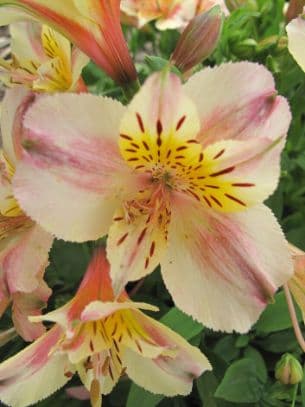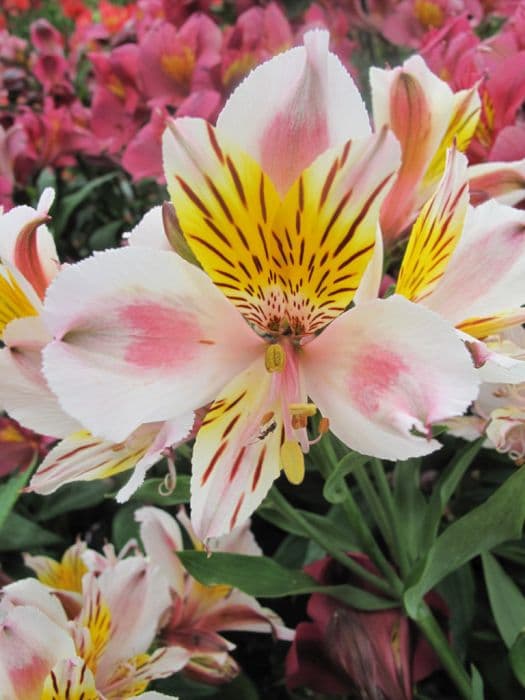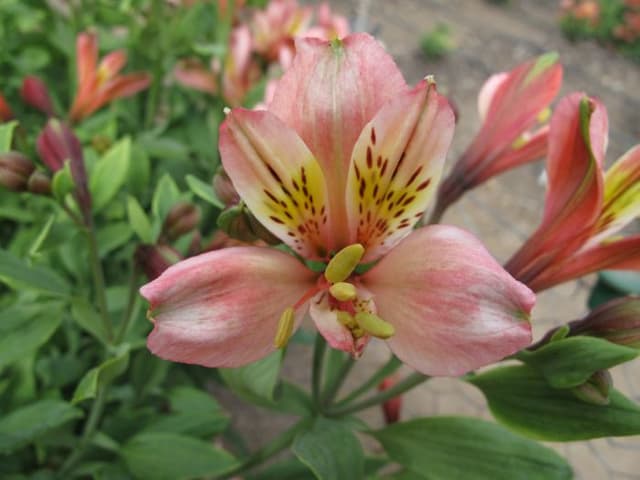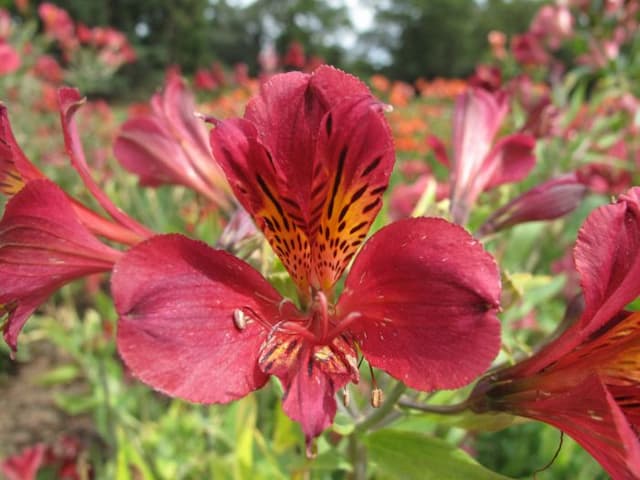Alstroemeria 'Christina' (PBR) (Little Miss Series)

ABOUT
Alstroemeria 'Christina' from the Little Miss Series is a striking perennial plant known for its vibrant and showy flowers. Its blooms are a stunning blend of pink and yellow hues, with each petal exhibiting a unique pattern of streaks and speckles, often in a darker pink or burgundy color which creates a delightful contrast with the lighter background. The flowers grow in clusters at the top of strong, upright stems, making them an eye-catching addition to any garden space. These blossoms are trumpet-shaped when viewed from the side, adding to their ornamental appeal. The foliage of Alstroemeria 'Christina' consists of lance-shaped leaves that are rich green in color. These leaves can appear glossy and have a slightly twisted form, which adds texture and interest even when the plant is not in bloom. The foliage arrangement is dense, making the plant appear lush and full. The aesthetic of the foliage complements the flowers, creating a harmonious look that is typical of the Alstroemeria genus. This attractive combination of floral beauty and leafy greenery makes Alstroemeria 'Christina' a beloved choice for cut flower arrangements and garden borders alike.
About this plant
 Names
NamesFamily
Alstroemeriaceae
Synonyms
Peruvian Lily, Lily Of The Incas, Parrot Lily
Common names
Alstroemeria 'Christina' (PBR) (Little Miss Series)
 Toxicity
ToxicityTo humans
The Alstroemeria, or Peruvian Lily, is generally considered to be non-toxic to humans. However, it's important to note that it can cause minor skin irritation in some individuals due to its sap, which contains allergenic compounds. Ingesting parts of the plant is not typically associated with poisoning or severe adverse effects, but it is always advisable to avoid eating ornamental plants as their edibility and safety are usually not established.
To pets
The Peruvian Lily is known for being non-toxic to pets, including cats and dogs. Ingesting this plant should not cause poisoning or serious health concerns. However, as with any non-food plant, ingestion can sometimes lead to mild gastrointestinal upset, such as vomiting or diarrhea, due to the irritation of the stomach and intestines. If a pet ingests a large quantity of the plant and shows signs of distress, it is recommended to consult a veterinarian.
 Characteristics
CharacteristicsLife cycle
Perennials
Foliage type
Deciduous
Color of leaves
Green
Flower color
Pink
Height
1 foot 2 inches (35 centimeters)
Spread
1 foot (30 centimeters)
Plant type
Herb
Hardiness zones
7
Native area
South America
Benefits
 General Benefits
General Benefits- Attractive Flowers: Alstroemeria 'Christina' produces eye-catching blooms with a mix of pink and yellow colors that add aesthetic appeal to gardens and arrangements.
- Long Blooming Period: This variety typically has a lengthy flowering season, which can extend from early summer to late fall.
- Good for Cut Flowers: The flowers are durable and long-lasting in vases, making them excellent for floral arrangements.
- Drought Tolerance: Once established, Alstroemeria 'Christina' is quite resilient to periods of low water, making it suitable for xeriscaping or low-maintenance gardens.
- Attracts Pollinators: The vibrant flowers are attractive to bees, butterflies, and other beneficial pollinators, enhancing the health and biodiversity of the garden.
- Compact Growth: Belonging to the Little Miss Series, this plant has a compact growth habit, making it ideal for small gardens or containers.
- Minimal Maintenance: Alstroemeria 'Christina' requires relatively low care, with no need for intricate pruning or special treatment.
 Medical Properties
Medical PropertiesThis plant is not used for medical purposes.
 Air-purifying Qualities
Air-purifying QualitiesThis plant is not specifically known for air purifying qualities.
 Other Uses
Other Uses- Photography Prop: Alstroemeria can be used by professional and amateur photographers as a beautiful, vibrant prop for still life or macro photography.
- Crafting: The petals of the Alstroemeria can be pressed and used in various crafting projects like homemade cards or bookmarks.
- Edible Cake Decorations: Though not commonly known for this use, the flowers can be crystallized with sugar and used as edible decorations on cakes and desserts.
- Educational Tool: Alstroemeria can be used in botany classes to teach about plant biology, hybridization, and flower structure.
- Perfume Inspiration: The delicate scent of Alstroemeria can inspire fragrance creators in the development of new perfumes.
- Eco-Friendly Confetti: Dried petals of Alstroemeria can be used as biodegradable confetti for weddings or celebrations.
- Art Supplies: The pigments from the flower can be used in the creation of natural dyes for textiles or for use in watercolor painting.
- Fashion Inspiration: Designers may draw inspiration from the vibrant colors and patterns of the Alstroemeria flowers for fashion designs.
- Table Centerpieces: Beyond simple vases, Alstroemeria can be arranged in creative centerpieces for banquets or home decor.
- Color Therapy: The bright and diverse colors of the Alstroemeria may be utilized in color therapy practices for their cheerful and uplifting effects.
Interesting Facts
 Feng Shui
Feng ShuiThe Peruvian Lily is not used in Feng Shui practice.
 Zodiac Sign Compitability
Zodiac Sign CompitabilityThe Peruvian Lily is not used in astrology practice.
 Plant Symbolism
Plant Symbolism- Wealth, Prosperity, and Fortune: Alstroemeria, or Peruvian Lily, commonly symbolizes wealth, prosperity, and fortune, due to its abundance of flowers and longevity after being cut, which can be seen as symbols of lasting success.
- Friendship and Devotion: The twists in the leaves of the Peruvian Lily, which grow upside down, represent the trials and tribulations that friendships endure, symbolizing the strength and mutual support within these relationships.
- Aspiration and Achievement: With its striking colors and patterns, the Peruvian Lily can also be interpreted as a symbol for striving towards goals and achieving personal growth.
- Mutual Support: Given its intricate blooms and enduring nature, the Peruvian Lily is often associated with the idea of standing by friends or loved ones, symbolizing a reciprocal understanding and support.
 Water
WaterThe Peruvian Lily should be watered regularly to keep the soil consistently moist but not waterlogged. During the growing season, water when the top inch of soil feels dry, typically amounting to about 1-2 gallons per week depending on climate and weather conditions. Reduce watering in the winter months when the plant is not actively growing. Ensure adequate drainage to prevent root rot. Water at the base of the plant to avoid wetting the foliage, which can lead to fungal diseases.
 Light
LightPeruvian Lilies thrive in a location that receives full sun or partial shade. They prefer bright, indirect light for most of the day with some protection from the intense heat of the afternoon sun. An east or west-facing spot with filtered sunlight is ideal to encourage abundant flowering.
 Temperature
TemperaturePeruvian Lilies perform best in temperatures ranging from 65 to 80 degrees Fahrenheit. They can survive minimum temperatures down to about 29 degrees Fahrenheit, but it is best to provide protection or bring them indoors if frost is expected. The ideal temperature range will promote healthy growth and flowering.
 Pruning
PruningPruning Peruvian Lilies is essential to remove spent blooms and encourage further flowering. Cut back the stems after flowering by about a third in the summer. Deadheading regularly will also promote a longer blooming period. Pruning to the ground is suggested in late fall or early winter after the foliage has died back, to tidy up the plant and prepare it for the next growing season.
 Cleaning
CleaningAs needed
 Soil
SoilThe best soil mix for the Peruvian Lily should well-draining and fertile, with a mix of loam, peat, and sand. It should have a slightly acidic to neutral pH, ranging from 6.0 to 7.0 for optimal growth.
 Repotting
RepottingPeruvian Lilies should be repotted every 2-3 years to refresh the soil and accommodate root growth. It's best to repot them in the spring before the growing season.
 Humidity & Misting
Humidity & MistingPeruvian Lilies thrive in moderate humidity levels; aim for humidity around 40-50% for ideal growth conditions.
 Suitable locations
Suitable locationsIndoor
Place in bright, indirect light with well-draining soil.
Outdoor
Plant in partial shade with shelter from strong winds.
Hardiness zone
7-10 USDA
 Life cycle
Life cycleThe Alstroemeria 'Christina', commonly known as Peruvian Lily or Lily of the Incas, begins its life cycle as a seed, which upon germination, develops into a small seedling. As it enters the vegetative stage, the plant grows leaves and stems, establishing a strong root system. During the flowering stage, which often occurs in summer, the Peruvian Lily produces distinctive, vibrant flowers that are popular in cut flower arrangements. After pollination, usually facilitated by insects, the plant may produce small, capsule-like fruits containing seeds, allowing for sexual reproduction and genetic diversity. Once the flowering season concludes, the plant may enter a period of dormancy, especially in colder climates, where it conserves energy and resources by minimizing growth. Throughout its perennial life cycle, the Peruvian Lily can live for several years, undergoing multiple cycles of growth, flowering, and dormancy.
 Propogation
PropogationPropogation time
Late Winter to Early Spring
Alstroemeria 'Christina', commonly known as Peruvian Lily or Lily of the Incas, is often propagated through division, which is the most popular method for this particular plant. This should ideally be done in the late summer to early fall. The plant forms tuberous roots and when these have become crowded, typically every two to three years, they can be gently lifted from the ground with a garden fork. After lifting, the clumps of tubers should be carefully divided into smaller sections, ensuring that each new section has at least one shoot or growing point. These sections can then be replanted in well-draining soil at a depth of approximately 6 to 8 inches (15 to 20 centimeters), spaced about 12 to 18 inches (30 to 45 centimeters) apart to allow for adequate growth and air circulation.
![Peruvian lily [Princess Carmina]](/_next/image?url=https%3A%2F%2Fplants-admin.emdemapps.com%2Fimages%2Fplants%2F%2Fimages%2F604b5b436505f.png&w=640&q=75)




![Peruvian lily [Inca Glow]](/_next/image?url=https%3A%2F%2Fplants-admin.emdemapps.com%2Fimages%2Fplants%2F%2Fimages%2F604b5e99e48d9.png&w=640&q=75)
![Peruvian lily [Inca Smile]](/_next/image?url=https%3A%2F%2Fplants-admin.emdemapps.com%2Fimages%2Fplants%2F%2Fimages%2F604b5cad8fa91.png&w=640&q=75)
![Peruvian lily [Inticancha Passion]](/_next/image?url=https%3A%2F%2Fplants-admin.emdemapps.com%2Fimages%2Fplants%2F%2Fimages%2F604b5f7a78c8d.png&w=640&q=75)

